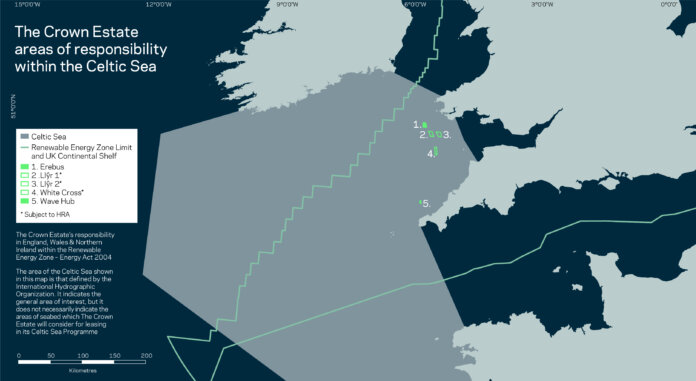The Crown Estate has developed proposals for floating wind in the Celtic Sea. It has published further details on its plans, confirming its ambition to unlock up to 4 GW of new clean energy capacity in England and Wales, and help establish a new industrial sector for the U.K.
The leasing process will deliver enough new capacity to provide clean power for almost four million more homes, in support of the UK’s net zero target, as well as creating opportunities for significant new investment in jobs, skills, and infrastructure.
“Floating wind technology offers a powerful opportunity to open up the renewable energy resources of the Celtic Sea, helping to tackle the climate crisis with additional clean power and ignite a new industrial sector,” says Huub den Rooijen, managing director of marine at The Crown Estate. “We are focused on realizing this potential in a way that supports the development of the regional supply chain and infrastructure, protects our marine environment, and harnesses the opportunity for local communities.”
The proposals include a focus on two key project categories: early commercial-scale projects (300-350 MW) and full-commercial scale projects (up to 1 GW). Leasing is designed at a pace and scale to support supply chain and infrastructure development, helping to underpin a sustainable future for the sector, and ensure Wales, the South West and the wider UK benefit from the industrial opportunity.
“The UK is a world leader in offshore wind deployment and floating technology is going to be vital in ensuring we meet our target of delivering 1 GW of floating offshore wind by 2030 – a key part of the Prime Minister’s Ten Point Plan,” states Energy, Clean Growth and Climate Change Minister Greg Hands. “Today’s proposals by The Crown Estate to expand our offshore wind capacity will help unlock the full potential of the UK’s seas, creating high-skilled jobs and driving investment – all while supporting the delivery of clean energy to millions of homes across the country.”
With a revised approach to spatial design and Habitats Regulations Assessment (HRA), The Crown Estate will conduct an integrated spatial design and Plan-Level HRA ahead of market tender to identify key environmental issues at the earliest opportunity, helping to de-risk investment, minimize environmental risk and streamline the overall program.
“The opportunity for floating offshore wind in the Celtic Sea offers substantial renewable energy to support a net zero Wales and puts us at the forefront of this fast-developing industry,” states Julie James, the Welsh Government’s Minister for Climate Change. “We welcome this announcement; it offers certainty for developers and helps us optimize the resources from the Celtic Sea while guarding against unacceptable impacts on the marine environment.”
The proposals will work with Electricity System Operator and others to support a coordinated grid solution for floating wind projects, in line with the work underway through the Offshore Transmission Network Review, to accelerate grid development and mitigate impacts on communities onshore.
The leasing process could see rights awarded by the end of 2023, with projects delivered from 2030 into the early part of the next decade.
The proposals for floating wind leasing in the Celtic Sea reflect The Crown Estate’s evolving approach to leasing offshore, which is designed to help address the strategic challenges facing renewable energy projects in our increasingly complex marine environment. These include the need to mitigate cumulative pressures on coastal and marine habitats, deliver socio-economic benefits for communities, minimize the impact of infrastructure, and improve coordination with other industries and activities at sea.
In order to facilitate these outcomes, The Crown Estate will now begin the next stages of its engagement with market and stakeholders on the floating wind program, which will take place in two phases over the winter of 2021-2022.
Phase one of this engagement will focus on the spatial design, gathering data and evidence to help inform the location of project sites. Phase two will invite views on the design of the market tender and the wider considerations of the program, including on supply chain, ports and grid, as well as community benefits, such as skills and employment.
To ensure a coordinated approach to assessing potential environmental impacts, the Llŷr and White Cross test and demonstration scale projects (announced earlier this year) will form part of the Plan-Level Habitats Regulations Assessment (HRA) for floating wind in the Celtic Sea.
“This announcement further reinforces the critical role floating wind will play in achieving the scale of installed capacity which will be required to deliver a cost-effective Net Zero,” comments Dan McGrail, CEO of RenewableUK. “It is a huge economic opportunity as well as an industrial challenge, requiring short and longer-term enabling actions ahead of the arrival of the first large scale projects – to ensure the UK capitalizes fully on ‘first mover’ advantage.”




